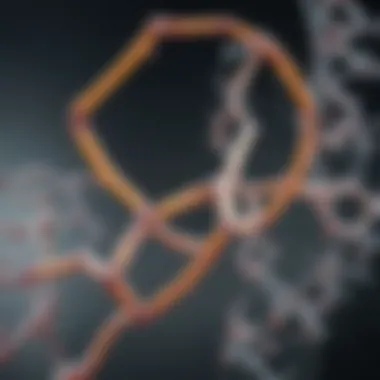Exploring PEG Reagents: Their Role in Science


Intro
In the realm of scientific research, the versatility of PEG reagents offers a treasure trove of opportunities for exploration and innovation. Polyethylene glycol, commonly known as PEG, has gained significant traction due to its unique properties and ability to enhance various processes across fields such as biology, chemistry, and pharmaceuticals. This compound is pivotal for multiple applications, from protein solubilization to drug delivery systems, allowing researchers to push the boundaries of what's conceivable in molecular science.
By delving into the functions, applications, and implications of PEG in scientific research, this article aims to demystify its role and underscore its importance in modern investigative practices. Whether you're a student new to this domain or an experienced researcher looking to refresh your knowledge, this exploration seeks to provide you with insights that resonate and ignite your curiosity.
Research Overview
Summary of Key Findings
PEG reagents stand out for their solubility in both aqueous and organic environments, making them highly adaptable. The research reveals several key areas where PEG plays a crucial role:
- Protein Solubilization: PEG aids in stabilizing proteins, enhancing their solubility and maintaining their activity, which is indispensable in biochemistry.
- Drug Delivery Systems: Due to its biocompatibility and ability to modify drug release profiles, PEG is increasingly utilized in formulating drug delivery vehicles.
- Bioconjugation Reactions: PEGylation, the process of attaching PEG molecules to proteins and other molecules, can improve therapeutic efficacy and reduce immunogenicity.
"PEG reagents have revolutionized how we approach molecular interactions and therapeutic designs. Their contributions extend far beyond simple solubility."
Methodologies Employed
To investigate the multifaceted roles of PEG reagents, a combination of experimental techniques and theoretical models was engaged:
- Spectroscopic Analysis: Techniques like NMR and UV-Vis spectroscopy helped in determining the interactions between PEG and various biomolecules.
- In Vitro Studies: Cellular assays provided insights into the biocompatibility and efficacy of PEG-modified compounds in biological systems.
- Comparative Analyses: Reviewing varying PEG molecular weights and their distinct impacts on biological functions offered a deeper understanding of how versatility translates to application.
The methodologies employed span a wide range, showcasing the adaptability of PEG reagents in research and the intricate balance between their chemical properties and biological applications.
Prolusion to PEG Reagents
In the landscape of molecular science, PEG reagents stand out as critical components with far-reaching implications across various fields of research. These compounds facilitate a myriad of processes that range from drug formulation to bioconjugation. Understanding PEG reagents is essential not only for researchers but also for industries looking to innovate and improve their products. This section delves into the fundamentals of PEG, bringing to light its definition, composition, and the historical context that shaped its current applications.
Definition and Composition
Polyethylene glycol (PEG) consists of long chains of ethylene oxide monomers, forming a versatile polymer. The composition of PEG varies, leading to a range of molecular weights, which allows for flexibility in its applications: from low molecular weight for drug solubility to high molecular weights for structural applications.
The general formula for PEG can be expressed as H−(O−C−C)n−OH. The repeating unit contributes to its solubility in both water and organic solvents, a duality that makes PEG a favored choice in many scientific manipulations.
Some key characteristics include:
- Solubility: Its amphiphilic nature enables it to dissolve in polar and nonpolar solutions.
- Biocompatibility: PEG is generally well-tolerated by biological systems, making it suitable for pharmaceutical applications.
- Flexibility: The variable molecular weight of PEG allows it to be tailored for specific uses.
This combination of features lays the groundwork for understanding how PEG reagents operate in diverse scientific and industrial applications.
Historical Context
The roots of polyethylene glycol can be traced back to the 1950s when it was first synthesized. Initially, PEG's use was limited mostly to industrial applications. However, as the understanding of its properties deepened, researchers began to explore its potential in pharmacology and biology. By the 1970s, significance burgeoned, particularly in drug delivery and bioconjugation techniques, leading to its adoption in formulations aimed at enhancing solubility and bioavailability.
The turning point came with the development of PEGylation—a process of attaching PEG chains to biomolecules, vastly improving their stability and circulation time in the bloodstream. This innovative use opened doors to a realm where traditional treatments could be enhanced, resulting in more effective therapies.
PEG reagents have evolved significantly, each advancement adding layers of complexity and capability, making them a cornerstone in the fields of synthetic and analytical chemistry.
Understanding their foundational aspects provides a gateway to appreciating their role in contemporary research, pushing the boundaries of science.
Chemical Properties of PEG
The chemical properties of polyethylene glycol (PEG) are central to understanding its various roles in scientific research and industrial applications. This section details several key characteristics, explaining why PEG is such a favored choice in a myriad of processes. These properties not only enhance its functionality but also define its safety profile, making it a versatile compound in fields ranging from pharmaceuticals to biotechnology.
Molecular Structure
The molecular structure of PEG consists of repeating units of ethylene glycol. This structure leads to a polymer that can vary in molecular weight, impacting its physical properties. Notably, a lower molecular weight tends to yield a more fluid substance, while a higher molecular weight results in a viscous entity. The linear nature of the PEG molecule allows for ease of modification, which is crucial for its applications in drug delivery and bioconjugation. Understanding this structure is vital, as it influences the interactions PEG will have with biological systems and other compounds. Additionally, its hydroxyl groups can form hydrogen bonds, enhancing its solubility in various aqueous environments.


Physicochemical Characteristics
The physicochemical characteristics of PEG play a major role in determining its utility in scientific and industrial applications. Aspects like solubility, viscosity, and thermal behaviors can make or break its efficacy in specific processes.
Solubility Profiles
PEG exhibits impressive solubility in water and many organic solvents due to its hydrophilic and hydrophobic segments. This property is beneficial for various applications. For instance, PEG's high water solubility allows it to be easily integrated into aqueous-based formulation processes. The unique characteristic of being soluble in a wide range of solvents makes PEG a reliable choice in formulation chemistry, ensuring that the active ingredients are effectively delivered.
However, one consideration is that higher molecular weight PEGs may present challenges in solubility, affecting their use in certain formulations. Still, for many applications, its solubility profile is a significant advantage, offering flexibility in formulation strategies.
Viscosity and Stability
PEG's viscosity and stability are two paramount traits that contribute to its performance in both laboratory and industrial settings. Lower molecular weight PEGs usually feature lower viscosity, providing ease of use in mixing and administration. On the contrary, higher molecular weight PEGs typically have a thicker consistency. This can be valuable in pharmaceuticals, where gel formulations may be desirable.
The stability of PEG under various conditions is another aspect that enhances its appeal. It can resist degradation under many environmentally demanding circumstances, ensuring that formulations remain effective over time. Nevertheless, a downside can be seen in formulations requiring lower viscosity while needing PEG's stability; choosing the correct molecular weight PEG becomes crucial to avoiding complications.
Thermal Properties
The thermal properties of PEG are also worth noting. PEG demonstrates a broad liquid range and does not crystallize easily, which makes it suitable for use in various temperature conditions. This characteristic is particularly important for applications such as drug delivery, where temperature fluctuations can impact the release rates of active compounds. Furthermore, PEG's ability to withstand heat without degrading translates into stability during processing.
Still, it is essential to carefully assess the thermal stability when choosing PEG for specific applications as not all molecular weights behave the same across thermal conditions. In summary, PEG's thermal properties impart significant flexibility in its use and under varying environmental conditions.
Roles of PEG Reagents in Scientific Research
PEG reagents play a crucial role in various facets of scientific research, essentially acting as a bridge between theory and application. They enhance the functionality of biomolecules, facilitate drug delivery mechanisms, and play a vital part in biochemical techniques. Understanding these roles, therefore, is key to appreciating their wider implications in both academic and industrial settings.
Protein Solubilization
In the realm of protein science, solubilization is a critical process. PEG reagents are known to improve protein solubility, an essential aspect when working with proteins that may otherwise be difficult to handle in aqueous solutions. What makes PEG particularly effective is its ability to create a favorable microenvironment for proteins that are sensitive to aggregation. By reducing surface tension and providing a protective coating around protein molecules, PEG minimizes the risk of denaturation. In research applications, this quality becomes invaluable when isolating specific proteins for further study or application.
Bioconjugation Techniques
Linking of Biomolecules
Linking biomolecules using PEG reagents has gained traction for its effectiveness in increasing the stability and solubility of conjugates. The primary aspect of this linking involves creating robust covalent bonds between different biomolecules, which might include proteins, nucleic acids, or others. The major allure of using PEG for such applications is its ability to enhance pharmacokinetics, leading to prolonged circulation time in biological systems. Additionally, the hydrophilic nature of PEG reduces the immunogenicity of the conjugated materials, making it a popular choice.
However, there is a caveat. The modification of biomolecules with PEG can sometimes hinder their biological activity, a downside that researchers must consider when designing experiments.
Modification of Therapeutics
The modification of therapeutics through PEGylation has become a pivotal aspect of drug development. PEG provides improved solubility and stability for drugs, which often experience degradation or poor absorption. The allure lies in its ability to alter pharmacokinetic properties, enabling longer-lasting therapeutic effects. When medications are modified with PEG, they often exhibit enhanced bioavailability, which is especially valuable for treatments requiring precise dosing.
Yet, this process is not devoid of challenges. The inclusion of PEG might impact the interaction of therapeutic agents with their target sites, potentially leading to a reduction in effectiveness. Researchers strive to strike a balance between enhancing properties while retaining efficacy.
Drug Delivery Systems
PEG reagents find significant application in drug delivery systems, where their unique properties can be harnessed to improve the efficiency of therapeutic agents.
Nanoparticles and Micelles
Nanoparticles and micelles created from PEG are noteworthy for their ability to encapsulate a variety of drugs, thus facilitating targeted delivery. These structures enhance solubility and improve the stability of the drugs they carry. The unique feature of these PEG-based systems lies in their versatility; they can be engineered to release their cargo under specific conditions, such as changes in pH or temperature. This targeted approach is particularly beneficial in cancer therapies, where precision is paramount.
On the flip side, the complex formulation and potential for varied responses in biological systems are factors that researchers must juggle when deploying these systems.
Controlled Release Mechanisms
Controlled release mechanisms utilizing PEG reagents allow for the sustained delivery of drugs over extended periods. Such systems can optimize the therapeutic effectiveness by maintaining consistent drug levels in the bloodstream, reducing the frequency of dosing. The key characteristic here is the capability to engineer the release kinetics, tailoring it to match the pharmacodynamics of the drug involved.


Nevertheless, such systems can come with drawbacks; the potential for unexpected release profiles can complicate dosage regimens. Achieving the desired balance of efficacy and safety is paramount when employing these controlled mechanisms in research and clinical applications.
"PEG reagents serve as versatile tools helping to bridge the gap between the laboratory bench and real-world clinical outcomes in scientific research."
In summary, the roles of PEG reagents in scientific research are multi-faceted. From facilitating protein solubilization and enabling bioconjugation to improving drug delivery systems, their benefits are substantial, albeit not without challenges. Understanding these roles is vital for anyone engaged in biochemical and pharmaceutical innovation.
Industrial Applications of PEG Reagents
The role of PEG reagents in various industries is nothing short of transformative. Their chemical properties and versatility render them indispensable in pharmaceutical, cosmetic, and food domains. In this section, we will delve into each of these areas, highlighting how PEG contributes to innovation and efficacy while also addressing some considerations that come with their use.
Pharmaceutical Formulations
PEG is pivotal in the pharmaceutical industry, particularly in drug formulation. Due to its solubility in both water and organic solvents, PEG is frequently utilized as a solvent and a base in various formulations. This functional benefit enhances bioavailability, a crucial factor in the effectiveness of medications.
Some key aspects of PEG in pharmaceuticals include:
- Stabilization: PEG helps stabilize proteins and enzymes, prolonging their shelf life and effectiveness.
- Facilitating Controlled Release: Drug delivery systems employing PEG can precisely control the release of therapeutics, which is vital for chronic conditions requiring consistent dosing.
- Improving Solubility: Poorly soluble drugs benefit from PEG’s properties, making it easier for patients to absorb medications, ultimately leading to improved therapeutic outcomes.
However, while the benefits are numerous, it’s equally important to consider the potential for PEG to trigger allergic reactions in certain individuals. Careful consideration of formulation components is essential to ensure patient safety.
Cosmetic Industry Uses
In the realm of cosmetics, PEG compounds shine brightly with their multi-functional properties. Brands often incorporate PEG in formulations for skin care products, hair care items, and makeup.
Some prominent functions in cosmetics include:
- Moisturizing Agent: PEG acts as a humectant, drawing water into the skin and helping to maintain hydration—a delightful benefit for both skin and hair.
- Emulsification: In creams and lotions, PEG aids in the formation and stabilization of emulsions, allowing for smooth application and texture.
- Thickening Agent: Many gel-like products utilize PEG for its ability to enhance viscosity without a sticky feel, appealing to consumers who prefer lightweight textures.
It's imperative for manufacturers to strike a balance between performance and safety in cosmetics. Hence, assessments of any skin irritants or harmful effects are paramount.
Food Industry Applications
Lastly, PEG has infiltrated the food industry, primarily as a processing aid and ingredient. Its contributions are notable in enhancing food quality and safety.
Some relevant applications of PEG in food include:
- Food Additive: PEG can act as a food emulsifier or stabilizer, improving the mixing of oil and water in various food products, such as salad dressings and sauces.
- Texture Agent: It helps modify the texture of food, making certain items more palatable while enhancing mouthfeel.
- Preservative: Some PEG formulations are beneficial in preserving moisture and extending the shelf life of processed foods.
Despite its advantages, consumers are becoming increasingly wary of synthetic additives, prompting the industry to pursue more natural alternatives. Thus, transparency in ingredient sourcing and formulation is becoming a priority in food production.
"PEG's versatility across industries attests to its importance, but industry professionals must navigate safety and regulatory landscapes with diligence."
Through these varied applications, it's evident that PEG reagents are vital in evolving industrial landscapes, enhancing product functionalities, and addressing consumer needs. As we progress, understanding the implications of leveraging PEG will remain crucial in advancing both safety and innovation.
Regulatory and Safety Aspects
Understanding the regulatory and safety aspects of PEG reagents is crucial in the realm of scientific research and industry applications. These aspects help ensure that PEG compounds are handled, used, and disposed of in safe manners, preventing potential harm to humans and the environment. Furthermore, researchers and companies working with PEG must adhere to these guidelines to avoid legal and ethical issues that could arise from non-compliance.
Toxicological Profiles
Toxicological evaluations of PEG reagents are key to understanding their safety. Generally, PEG is considered biocompatible, but depending on the molecular weight and specific derivatives used, there can be variation in toxicity.
- Low Molecular Weight PEGs: Often used in pharmaceutical formulations, low molecular weight PEGs tend to have higher solubility and lower toxicity characteristics, making them suitable for drug delivery applications.
- High Molecular Weight PEGs: Used for functions such as protein solubilization, these compounds can sometimes show immunogenic responses in certain individuals, leading to adverse effects. This highlights the need for precise control in their use.
- Degradability: It’s essential to study how PEG breaks down and its metabolites’ impact on both human health and the environment. Some studies indicate that certain PEG derivatives can persist in biological systems, posing a risk over time.
Careful consideration and thorough testing are necessary to establish a comprehensive toxicological profile for each specific PEG compound to inform safe usage.
Regulatory Guidelines


Compliance with regulatory guidelines is non-negotiable. Various regulatory bodies oversee the use of PEG reagents, and understanding their requirements guides researchers and manufacturers.
- FDA Regulations: In the United States, the Food and Drug Administration regulates PEG used in pharmaceuticals. PEG must be approved based on rigorous safety and efficacy testing.
- EU Regulations: In Europe, PEG compounds are evaluated under REACH (Registration, Evaluation, Authorisation and Restriction of Chemicals), which requires extensive safety data on chemical substances.
- Labeling Requirements: Both regions mandate clear labeling on product packaging regarding the percentage of PEG and any potential hazards or contraindications.
"Non-compliance can result in not only financial penalties but also harm to public health and the environment, making adherence to regulatory guidelines vital."
It's imperative for all stakeholders—ranging from research labs to manufacturers—to remain vigilant and informed about evolving regulations regarding PEG usage. Keeping abreast of safety data sheets (SDS) is also a dependable practice in ensuring the chemical is handled with optimal safety.
In summary, the regulatory and safety aspects of PEG reagents encompass a broad range of evaluations and guidelines that dictate responsible usage. From toxicological profiles to compliance with regulatory bodies, a thorough understanding ensures that these critical compounds can be used effectively and safely in both research and industrial frameworks.
Recent Advancements in PEG Research
Recent advancements in PEG research have significantly expanded its role in scientific and industrial applications. The dynamic nature of this field illustrates the evolving understanding of polyethylene glycol and its derivatives, leading to innovative practices that address pressing challenges in various sectors.
Innovative Synthesis Techniques
One of the notable trends in PEG research is the development of innovative synthesis techniques. Traditional methods of synthesizing PEG often had limitations, such as scalability and purity of the final product. Newer techniques, such as "click chemistry" and enzymatic synthesis, have come to the forefront. These methods provide a more efficient pathway to create pure PEG compounds with precise molecular weights, which are essential in applications ranging from pharmaceuticals to biocatalysis.
The advantages of these modern techniques go beyond just efficiency.
- Cost-Effective: By minimizing the number of steps needed in the synthesis process, researchers can lower production costs.
- Eco-Friendly: Enzymatic methods, in particular, often require milder conditions and less harsh chemicals, making them more environmentally friendly.
- High specificity: The ability to create specific PEG derivatives tailored for targeted applications enhances the versatility of PEG in research.
Emerging Applications
Emerging applications of PEG reagents demonstrate their pivotal role in advancing scientific research. From drug delivery systems to bioconjugation strategies, PEG is proving to be more than just a passive ingredient; it is fundamentally changing the landscape of medical and biotechnological applications.
PEG Derivatives
The realm of PEG derivatives is exceptionally diverse, providing unique functionalities that make them popular in scientific fields. When talking about PEG derivatives, a crucial aspect includes their varying molecular weights, which can be tailored for specific needs. This customization allows researchers to match PEG derivatives with their desired application.
"The versatility of PEG derivatives greatly contributes to their demand in the formulation of biopharmaceuticals and therapeutic compounds."
Key characteristics include:
- Solubility: PEG derivatives often exhibit excellent solubility in water, which is an essential attribute when formulating drugs that require quick dissolution.
- Biocompatibility: Their non-toxic nature makes PEG derivatives suitable for medical applications, particularly in drug formulations.
- Length variability: The ability to control the length of PEG chains enables the design of materials with desired physical and chemical properties.
However, some of their unique features can also be double-edged swords. For instance, while the high solubility is usually advantageous, it can lead to rapid clearance from the body in some applications, limiting efficacy.
Smart Delivery Systems
Smart delivery systems represent one of the most exciting advancements in PEG research. These systems utilize intelligent design principles to improve the efficacy and targeting capabilities of drugs. A key characteristic of these systems is their ability to release therapeutic agents in response to specific stimuli, such as changes in pH or temperature.
- Responsive formulations: Such systems can be programmed to release their payload only when they reach the targeted site, enhancing effective treatment while minimizing side effects.
- Versatility: Smart delivery systems can be designed to carry a variety of drugs, whether they are small molecules or large biologics, making them very flexible in application.
The unique features of smart delivery systems bring considerable advantages. They enhance the pharmacokinetics of drugs, allowing for sustained and controlled release. However, on the downside, developing these systems requires a deep understanding of both the drug's properties and the physical environment in which it will function, which can complicate production processes.
In sum, recent advancements in PEG research are not only refining how PEG is used but also opening windows to new possibilities that significantly impact science and industry.
The End
The conclusion serves as the foundation upon which a greater understanding of PEG reagents is built. It wraps together the central themes explored throughout the article, emphasizing the multifaceted roles that polyethylene glycol plays in scientific research and applications. One cannot overlook its significance across multiple industries ranging from pharmaceuticals to cosmetics and even food. The versatility of PEG is a testament to its value, as it seamlessly integrates into various scientific methods while enhancing efficacy and safety.
Summation of Key Points
Summarizing the key points helps to anchor the reader’s comprehension and retention of the material presented in this exploration of PEG reagents:
- Definition and Composition: PEG is a polymer composed of repeated units of ethylene glycol. Understanding its basic composition facilitates a grasp of its chemical behavior.
- Chemical Properties: The unique molecular structure and physicochemical traits of PEG, such as solubility in a range of solvents, play a crucial role in its adaptability within biochemical processes.
- Roles in Research: PEG reagents are indispensable in protein solubilization, facilitating bioconjugation, and enhancing drug delivery systems. These functions are pivotal in advancing both synthetic and analytical chemistry.
- Industrial Applications: Industries harness PEG’s properties for drug formulations, cosmetics, and food products, outlining its broad commercial relevance.
- Regulatory Considerations: Safety profiles and regulatory guidelines must be acknowledged for ensuring responsible use of PEG, which underscores the importance of toxicity assessments.
- Recent Advancements: Ongoing research is directing attention to innovative synthesis techniques and emerging applications such as smart delivery systems, indicating the dynamic nature of PEG technology.
Future Perspectives
Looking ahead, the future of PEG research seems promising. As new synthesis methods are being developed, like bio-based PEGs, they may offer more environmentally sustainable alternatives to traditional processes. Emerging applications propose exciting directions; for instance, PEG derivatives could lead to specialized compounds with enhanced performance in targeted drug delivery systems. Moreover, as regulatory frameworks tighten globally, research into the safety profiles of PEG might see breakthroughs that will further validate its use in various formulations.
On a broader scale, the move towards personalized medicine coupled with PEG technology may usher in a new era of therapies tailored to individual patient needs. Overall, the momentum surrounding PEG research reflects an evolving landscape that promises to hold significance for scientists and industry professionals alike, driving innovation and expanding utility in scientific research and beyond.
"Innovative applications of PEG in biomedicine may redefine treatment methodologies and patient outcomes in the years to come."















